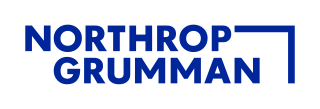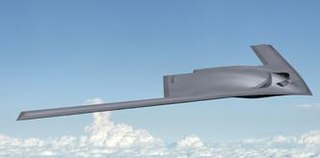The Lockheed Martin Corporation is an American aerospace and defense manufacturer with worldwide interests. It was formed by the merger of Lockheed Corporation with Martin Marietta in March 1995. It is headquartered in North Bethesda, Maryland. As of January 2022, Lockheed Martin employs approximately 115,000 employees worldwide, including about 60,000 engineers and scientists.

The Grumman Aircraft Engineering Corporation, later Grumman Aerospace Corporation, was a 20th century American producer of military and civilian aircraft. Founded on December 6, 1929, by Leroy Grumman and his business partners, it merged in 1994 with Northrop Corporation to form Northrop Grumman.

Northrop Grumman Corporation is an American multinational aerospace and defense company. With 95,000 employees and an annual revenue in excess of $30 billion, it is one of the world's largest weapons manufacturers and military technology providers. The firm ranked No. 101 on the 2022 Fortune 500 list of America's largest corporations.
Leidos Holdings, Inc. is an American defense, aviation, information technology, and biomedical research company headquartered in Reston, Virginia, that provides scientific, engineering, systems integration, and technical services. Founded as Science Applications International Corporation (SAIC),[6] Leidos merged with Lockheed Martin's IT sector, Information Systems & Global Solutions, in August 2016 to create the defense industry’s largest IT services provider. The Leidos-Lockheed Martin merger is one of the biggest transactions thus far in the consolidation of the defense sector. Leidos contracts extensively with the Department of Defense, the Department of Homeland Security, and the Intelligence Community, as well as other U.S. government agencies and select commercial markets.
Litton Industries, Inc., was an American defense contractor that specialized in shipbuilding, aerospace, electronic components, and information technology. The company was founded in 1953 and was named after inventor Charles Litton Sr., who was also an early investor in the company.
Orbital Sciences Corporation was an American company specializing in the design, manufacture, and launch of small- and medium- class space and launch vehicle systems for commercial, military and other government customers. In 2014, Orbital merged with Alliant Techsystems (ATK) to create a new company called Orbital ATK, which in turn was purchased by Northrop Grumman in 2018.
General Atomics (GA) is an American energy and defense corporation headquartered in San Diego, California, that specializes in research and technology development. This includes physics research in support of nuclear fission and nuclear fusion energy. The company also provides research and manufacturing services for remotely operated surveillance aircraft, including the Predator drones, airborne sensors, and advanced electric, electronic, wireless, and laser technologies.

The Defense Contract Audit Agency (DCAA) is an agency of the United States Department of Defense under the direction of the Under Secretary of Defense (Comptroller). It was established in 1965 to perform all contract audits for the Department of Defense. Previously, the various branches of military service were responsible for their own contract audits. The DCAA's duties include financial and accounting advisory services for the Department of Defense in connection with negotiation, administration and settlement of contracts and subcontracts.

The Contract Field Teams program is a program of the United States Air Force designed to provide temporary and long-term labor support for a variety of technical service needs; maintenance and repair, depot services, inspections, modernization for contingency support for aircraft, vehicles, weapon systems and other equipment. The CFT program is currently administered by the Oklahoma City Air Logistics Center at Tinker Air Force Base, and has been in place since 1951.

The Next-Generation Bomber was a program to develop a new medium bomber for the United States Air Force. The NGB was initially projected to enter service around 2018 as a stealthy, subsonic, medium-range, medium payload bomber to supplement and possibly—to a limited degree—replace the U.S. Air Force's aging bomber fleet. The Long Range Strike Bomber (LRS-B) heavy bomber program superseded the NGB program.
ManTech International Corporation is an American defense contracting firm based in Herndon, Virginia. It was co-founded in 1968 by Franc Wertheimer and George J. Pedersen. The company uses technology to help government and industry clients. The company name "ManTech" is a portmanteau formed through the combination of "management" and "technology."

MDA Ltd. is a Canadian space technology company headquartered in Brampton, Ontario, Canada, that provides geointelligence, robotics and space operations, and satellite systems.
Braddock, Dunn & McDonald, later known as BDM, then BDM International, was a technical services firm founded in 1959 in New York City. Its founders were Dr. Joseph V. Braddock, Dr. Bernard J. Dunn, and Dr. Daniel F. McDonald, who each received a PhD from Fordham University in the Bronx, New York. In 1997, TRW purchased BDM, and in 2002 Northrop Grumman bought TRW.

The Long Range Strike Bomber (LRS-B) is a development and acquisition program to develop a long-range strategic bomber for the United States Air Force, intended to be a heavy-payload stealth aircraft that can deliver thermonuclear weapons. Initial capability is planned for the mid-2020s. A request for proposals to develop the aircraft was issued in July 2014. The Air Force plans to procure at least 100 and potentially up to 200 of the LRS-B aircraft for an estimated $550 million each. A development contract was awarded to Northrop Grumman for its B-21 Raider in October 2015. Much about the project is highly classified and little information is available to the public. As of late 2019, it was known that construction of the aircraft had begun, and on December 2, 2022, it was unveiled to the public.
M.C. Dean, Inc. is a design-build and systems integration corporation for complex, mission-critical organizations. Started in 1949 as a small electrical firm, it has since grown to 5,800 employees and a revenue of approximately $1.3 Billion. It’s headquartered in Tysons, Virginia, United States, and has over 30 other offices, including branches in Atlanta, Georgia; Baltimore, Maryland; Tampa, Florida; Charleston, South Carolina; Stuttgart, Germany; and Dallas, Texas.

Stu Shea is an American business executive and leader and intelligence professional serving in a leadership capacity to public and private companies, as well as an advisor to government agencies, private equity investors, and academic institutions. Shea is the former chairman, president and chief executive officer of Peraton, a national security technology company. He is also the former president and chief operating officer of Leidos, chief operating officer of Science Applications International Corporation (SAIC), and founder and emeritus chairman of the United States Geospatial Intelligence Foundation.
Wesley G. Bush is an American systems engineer and business executive. He is the former CEO and chairman of Northrop Grumman, and he is currently a director of General Motors, Dow Inc., and Cisco.
Engility Holdings, Inc. was an American publicly traded company that provided engineering and logistics services to several United States Armed Forces and civilian agencies. The company based in Chantilly, Virginia was formed in 2012 as a spin-off of the services division of L3 Technologies. As of 2017, Engility reports an annual revenue of about $2 billion. On September 10, 2018, Science Applications International Corporation announced it was buying Engility for about $2.5 billion with the brand being retired.

The LGM-35 Sentinel, also known as the Ground Based Strategic Deterrent (GBSD), is a future American land-based intercontinental ballistic missile system (ICBM) currently in the early stages of development. It is slated to replace all 450 Minuteman III missiles from 2029 through 2075. The Minuteman missiles are currently stationed in North Dakota, Wyoming, Montana, and Nebraska.









